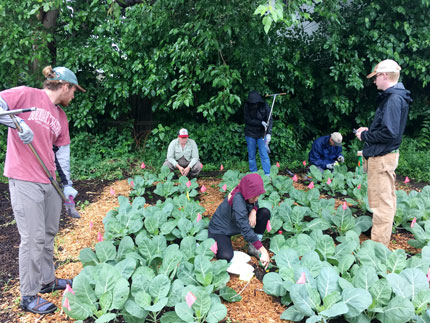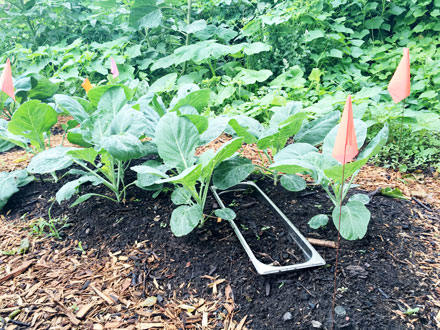Soil Science Society of America
5585 Guilford Road • Madison, WI 53711-5801 • 608-273-8080 • Fax 608-273-2021
www.soils.org
Twitter | Facebook
NEWS RELEASE
Contact: Hanna Jeske, Associate Director of Marketing and Brand Strategy, 608-268-3972, hjeske@sciencesocieties.org
What do gardens bring to urban ecosystems?
March 13, 2019 - “A healthy community requires healthy soil.” This idea spurred a consortium of researchers, farmers, and community garden practitioners to dive into the challenges—and opportunities—of urban agriculture. Their efforts, now in a second year, may highlight how urban soil can be a resource for human and environmental health.
“We can benefit from how we manage the environment,” says researcher Jennifer Nicklay. “Clean water, clean air, and agriculture benefit us, our waterways, and wildlife. We put a value on crop yield, which is all well and good. But in urban ag, we’re in such proximity to other humans. The other benefits become really important to think of as a whole.”
 Nicklay is a doctoral student at the University of Minnesota. Along with researchers at the University of St. Thomas and Hamline University, all located in the Minneapolis/St. Paul region, Nicklay is working with four urban growers to understand the contributions of city soils.
Nicklay is a doctoral student at the University of Minnesota. Along with researchers at the University of St. Thomas and Hamline University, all located in the Minneapolis/St. Paul region, Nicklay is working with four urban growers to understand the contributions of city soils.
The growers have unique approaches to their urban plots. One group emphasizes community building and education, another culturally-relevant food. Another uses a community-supported agriculture model, while a final group emphasizes community reconciliation over yield.
For all groups, land permanence in the urban environment is a challenge. A lease may expire, a city code may prevent perennial plantings, or a tax burden prove unmanageable. “When you don’t know how long you’ll be there, it’s hard to invest in long-term solutions,” Nicklay says. “All the growers value land tenure and land access.”
From the growers’ perspective, “healthy soil” means it has enough organic matter and nutrients to encourage good plant growth. It’s loose instead of compacted so water can move freely. From here, the concept of a “healthy community” moves upwards from the microbiome of helpful soil bacteria to insects, wildlife, and humans.
There’s often more than just soil in the soil, from copper wires to chemical contamination. This challenges the growers. Researchers hope to also determine if they can leave the urban plots better than they found them.
The team is comparing the findings to another urban farm owned and monitored by the University of St. Thomas. They are also comparing the urban ag plots to urban green spaces such as parks. To do so, researchers gather soil and plant samples—some weekly, some less often—for 20 different lab tests. The results will provide information on urban ag’s ecosystem services: changes to microbe and insect populations, water quality, soil fertility, and greenhouse gas emissions. Researchers also measure how much each urban plot will grow given different growing practices.
The two distinct growing experiences build on each other. “The University of St. Thomas farm allows us to scaffold the data. We can control more variables, see patterns and put them into context. In the less-controlled scenarios of our four urban growers we see the range of possibilities in the real world,” Nicklay explains.
 The team operates within a unique collaborative model. An annual “All Hands” meeting in the waning winter months unifies community and university participants with common goals. Weekly workdays and check-ins during the growing season maintain contact with grower sites to help share findings and address concerns. Community meetings and events throughout the year continue this close relationship.
The team operates within a unique collaborative model. An annual “All Hands” meeting in the waning winter months unifies community and university participants with common goals. Weekly workdays and check-ins during the growing season maintain contact with grower sites to help share findings and address concerns. Community meetings and events throughout the year continue this close relationship.
“These regular, repeated interactions—in ways that are both related and not related to the project—are really, really important,” Nicklay emphasizes. “It allows us to honor grower and community knowledge in all aspects of our work, from generating questions to designing methods to analyzing data.”
Nicklay says the process is time-intensive but rewarding. “When something hasn’t gone well, they tell me. We’re able to work through it,” she says. “We’re getting so much from the farmers. We want to give back and answer community questions. We make sure people know we’re here and invested in their success.”
This research project will conclude in 2020. Researchers hope their findings will help urban growers and policymakers make better land use decisions.
“We need local, data-driven evaluation of these ecosystem services to complement our narratives and experiments in order to maximize land use strategies,” Nicklay says. “Already, we’re thinking to the future. We know that there are innumerable community and home gardens in Minneapolis and St. Paul, and we want to figure out how to capture the impacts they are having. We can help researchers, growers, communities, and policymakers understand the potential impacts of urban agriculture at this larger scale.”
Nicklay presented this project at the Soil Science Society of America International Soils Meeting, Jan. 6-9, in San Diego. Funding from the USDA North Central Region Sustainable Research and Education Grant and the University of Minnesota Consortium on Law and Values in Health, Environment, and Life Sciences supports this continuing research.
Read more about soil’s ecosystem services here.